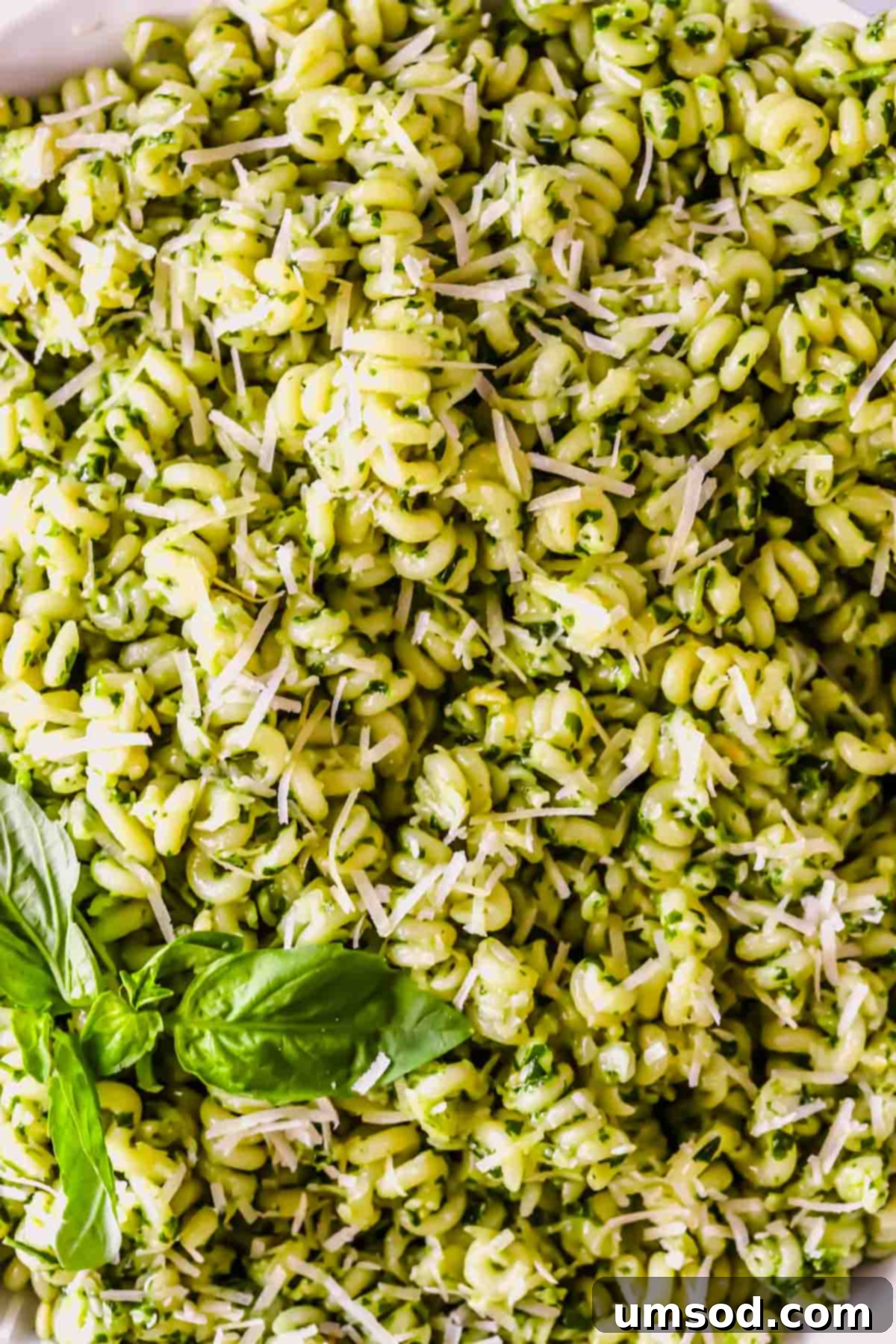Ultimate Basil Pesto Pasta: A Quick & Flavorful Weeknight Delight
Craving a dish that’s bursting with fresh flavors, incredibly satisfying, and ready in a flash? Look no further than this ultimate basil pesto pasta recipe! It’s the perfect solution for those busy weeknights when you need a delicious meal without spending hours in the kitchen. Imagine tender pasta coated in a bright, herbaceous, and utterly irresistible homemade pesto sauce – a true comfort food masterpiece that comes together in as little as 15 minutes. This recipe isn’t just fast; it’s a vibrant celebration of fresh basil, nutty parmesan, and rich olive oil, promising a taste experience that will delight your entire family. Get ready to elevate your dinner routine with this simple yet sophisticated pasta dish!

Pin this now to find it later
Pin It
Why You’ll Adore This Basil Pesto Pasta Recipe:
If your family, like mine, has an undeniable love for pasta, then this basil pesto pasta recipe is destined to become a new favorite. It’s a dish that artfully combines layers of flavor, giving the impression of an elaborate, all-day culinary endeavor, yet it miraculously comes together in mere minutes. Here’s why this recipe stands out:
- Lightning-Fast Preparation – This is truly a champion of speed! With just 5 minutes of active prep time and a quick 10 minutes for cooking, you’ll be serving up a hearty, homemade meal faster than ordering takeout. It’s the ultimate solution for those hectic evenings when time is precious, but you still crave something incredibly satisfying and homemade.
- Explosion of Fresh Flavors – Experience a harmonious blend of rich, buttery pasta perfectly balanced with the bright, aromatic essence of fresh basil pesto. Each forkful delivers a symphony of tastes – the sweet, peppery notes of basil, the nutty crunch of pine nuts, the savory depth of Parmesan, and a hint of zesty lemon. This dynamic flavor profile is genuinely addictive and guaranteed to have everyone reaching for seconds.
- Incredibly Versatile & Adaptable – While it shines as an effortless weeknight main course, this pesto pasta is also wonderfully adaptable. It can gracefully serve as a vibrant side dish alongside your favorite grilled meats or roasted vegetables. Feeling creative? Easily transform it into a more substantial meal by mixing in your preferred protein like grilled chicken, shrimp, or even chickpeas. For an added nutritional boost and burst of color, toss in extra veggies like cherry tomatoes, spinach, or roasted bell peppers. The possibilities are endless, making it a truly flexible recipe for any occasion.

Mastering Your Pesto Pasta: Key Ingredient Insights
The secret to an exceptional basil pesto pasta lies in the quality and careful selection of its core ingredients. Each component plays a crucial role in building the vibrant flavor and irresistible texture of this dish.
Crafting the Perfect Basil Pesto
- Fresh Basil Leaves – The star of the show! For the most aromatic and flavorful pesto, always opt for the freshest basil you can find. Look for vibrant green leaves free from wilting or dark spots. If you’re lucky enough to have it growing in your garden, that’s ideal. Otherwise, select a healthy bunch from your local grocery store. The quality of your basil directly impacts the pesto’s overall freshness and taste.
- Pine Nuts – A traditional cornerstone of authentic pesto, pine nuts contribute a delicate, buttery flavor and a subtle creaminess. They are essential for that classic pesto character. If you have nut allergies in your household or simply prefer an alternative, feel free to substitute with other nuts or seeds like walnuts (for a stronger, earthy flavor), cashews (for extra creaminess), or even sunflower or pumpkin seeds for a nut-free option. Lightly toasting them before adding can enhance their flavor.
- Parmesan Cheese – No pesto is truly complete without the savory, salty, and nutty goodness of Parmesan. We highly recommend using freshly grated Parmesan from a high-quality block. Pre-grated varieties often contain anti-caking agents that can hinder smooth melting and slightly mute the flavor. For a more pungent, salty kick, you could also experiment with Pecorino Romano.
- Extra Virgin Olive Oil – Beyond merely loosening the pesto ingredients, high-quality extra virgin olive oil is integral to the sauce’s rich texture and complex flavor profile. It imparts a fruity, slightly peppery note and provides a boost of healthy monounsaturated fats. Choose a good quality, cold-pressed olive oil for the best results; it makes a noticeable difference.
- Fresh Garlic Cloves – Garlic adds a pungent, aromatic depth that is fundamental to pesto. Fresh cloves are paramount for that vibrant, spicy kick. Feel free to adjust the quantity based on your personal preference – garlic lovers might even add an extra clove or two! For a milder garlic flavor, you could try roasting the cloves briefly before adding them to the food processor.
- Fresh Lemon Juice – A squeeze of fresh lemon juice is a game-changer! Its bright acidity cuts through the richness of the olive oil and cheese, balancing the flavors beautifully and adding a refreshing, zesty lift to the pesto. Always use freshly squeezed lemon juice for superior taste; bottled varieties simply don’t compare.
Choosing the Perfect Pasta
- Fusilli Corti Pasta (or your preferred shape) – While fusilli corti (short spirals) or cavatappi are excellent choices for this dish due to their delightful spiral shape and ridges that brilliantly capture and hold the rich pesto sauce, feel free to use any pasta shape you love. Other fantastic options include penne, rotini, farfalle (bow ties), or even long strands like spaghetti or linguine, which allow the sauce to cling beautifully to each strand. The key is to select a shape that will maximize sauce adhesion.
- Kosher Salt (for Pasta Water) – This is a non-negotiable step for perfectly seasoned pasta! Culinary wisdom dictates salting your pasta water “like the ocean,” and for good reason. Generously salting the water infuses the pasta with flavor from the inside out, preventing bland noodles. It’s the foundation of a truly delicious pasta dish.
- Unsalted Butter – A touch of unsalted butter added to the cooked pasta provides a luxurious, silky texture and a subtle richness that complements the pesto. It helps create a smoother, more cohesive sauce. It’s crucial to use unsalted butter so you can precisely control the seasoning of your dish. Opt for a high-quality butter for the best flavor.
- Parmesan Cheese (for Garnish) – Reserve a generous portion of freshly grated Parmesan to sprinkle over the finished dish. This final flourish adds an extra layer of savory, nutty flavor and a beautiful visual appeal. In my opinion, there’s truly no such thing as too much cheese when it comes to basil pesto pasta!
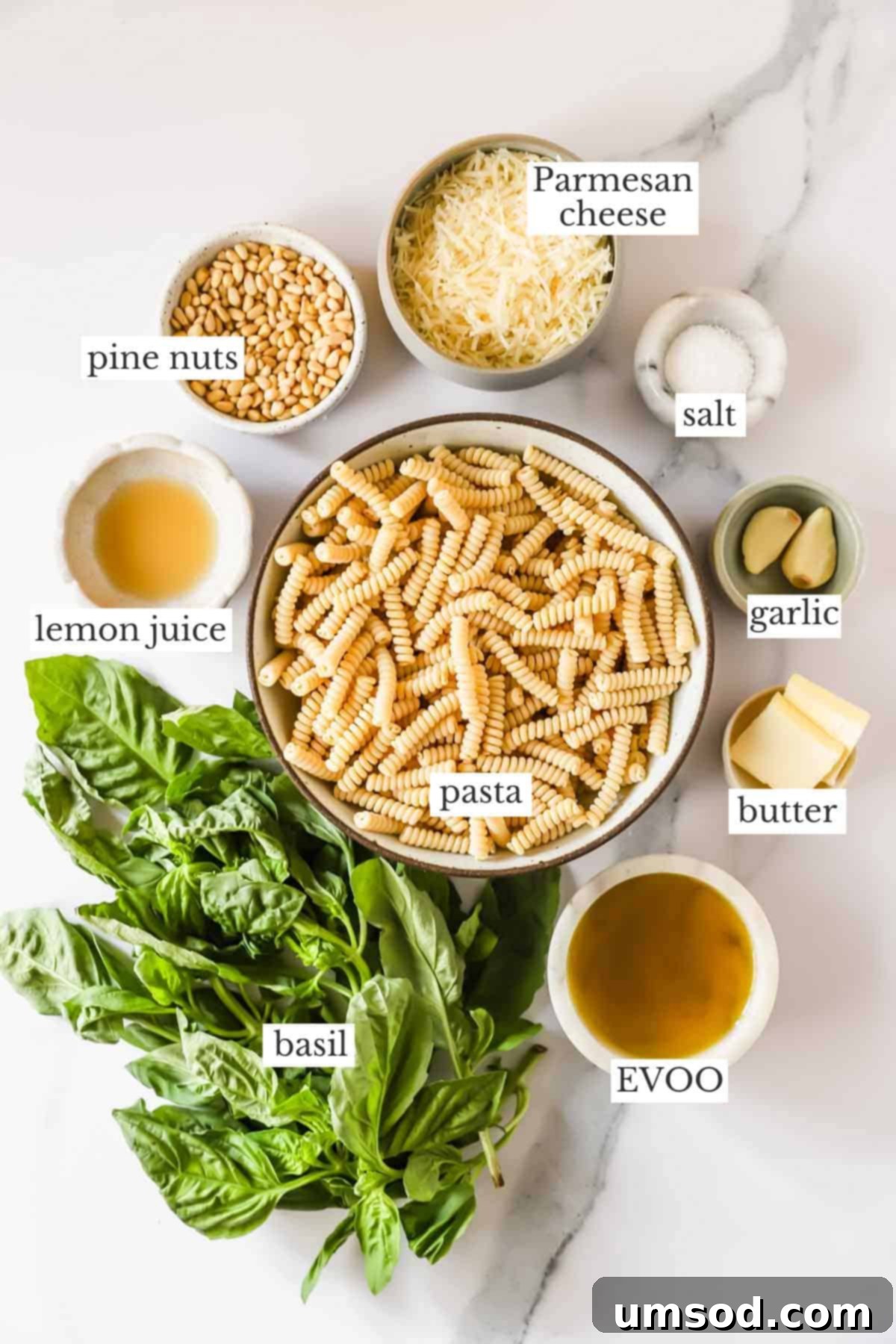
Step-by-Step Guide: How to Craft This Delicious Pesto Pasta Recipe
Preparing this exquisite basil pesto pasta is wonderfully straightforward, designed for maximum flavor with minimal effort. Follow these simple steps to bring this vibrant dish to life:
Part 1: Mastering Your Homemade Basil Pesto
- Combine Dry Ingredients: Begin by adding the fresh basil leaves, pine nuts, freshly grated Parmesan cheese, garlic cloves, fresh lemon juice, and kosher salt into the bowl of your food processor.
- Pulse to Perfection: Pulse the mixture a few times until all the ingredients are well combined and finely chopped. You want a coarse, somewhat chunky texture before adding the oil.
- Emulsify with Olive Oil: With the food processor running on low, slowly drizzle in the extra virgin olive oil through the feed tube. Continue to process until the pesto reaches a smooth, yet still slightly textured, sauce-like consistency. Be careful not to overprocess, as this can generate heat and cause the basil to turn slightly bitter or create a watery pesto. The goal is a vibrant, thick, and pourable sauce.
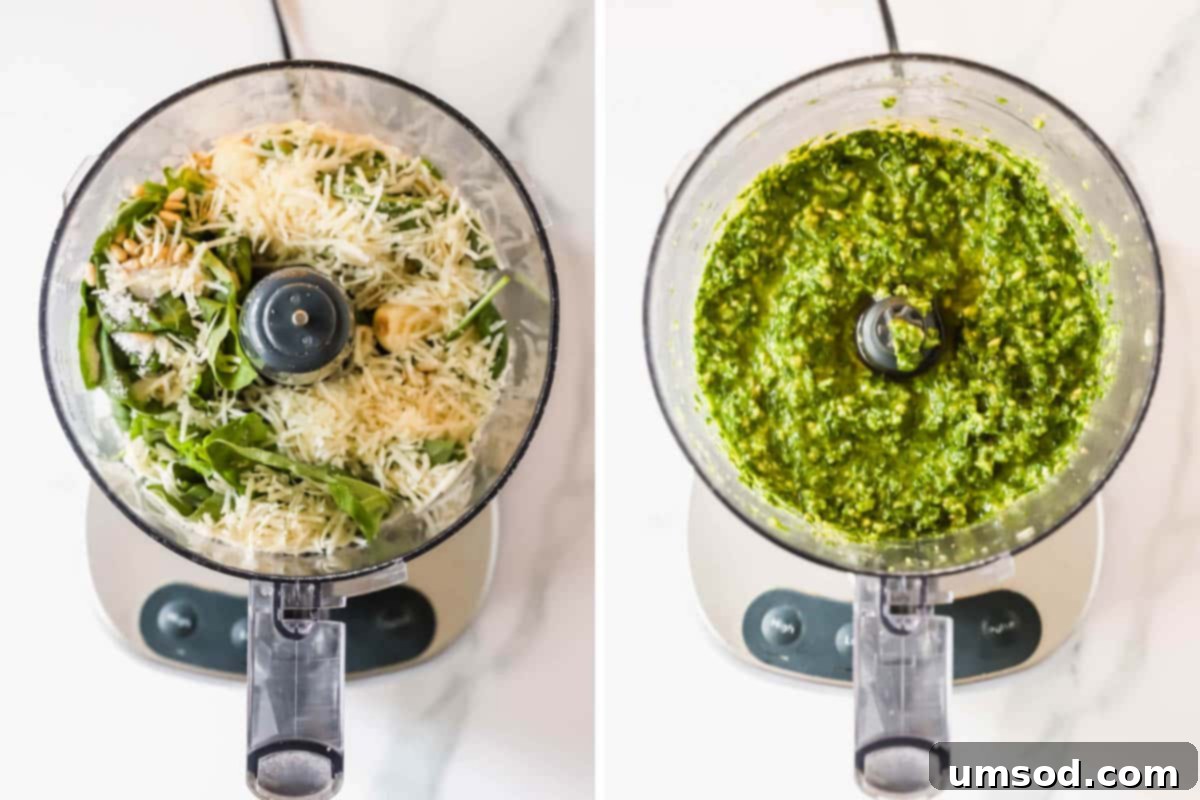
Part 2: Cooking the Pasta and Bringing It All Together
- Cook the Pasta: In a large pot of generously salted boiling water, cook your chosen pasta according to the package instructions until it reaches a perfect al dente texture. This means it should be tender but still have a slight firmness when bitten.
- Reserve Pasta Water & Drain: Before draining the pasta, make sure to reserve about ¼ cup of the starchy pasta cooking water. This “liquid gold” is essential for creating a silky-smooth sauce that beautifully coats the noodles. Once reserved, drain the remaining water from the pasta.
- Butter & Hydrate: Transfer the drained, hot pasta back into the pot. Immediately add the unsalted butter and the reserved pasta water. Gently toss and stir to combine, allowing the butter to melt and the starchy water to create a light, emulsified base that will help the pesto adhere to every strand.
- Combine with Pesto: Now, add your freshly made basil pesto to the buttered pasta. Mix thoroughly but gently, ensuring every noodle is evenly coated in the vibrant green sauce. The heat from the pasta will subtly warm the pesto, releasing its full aroma and flavor.
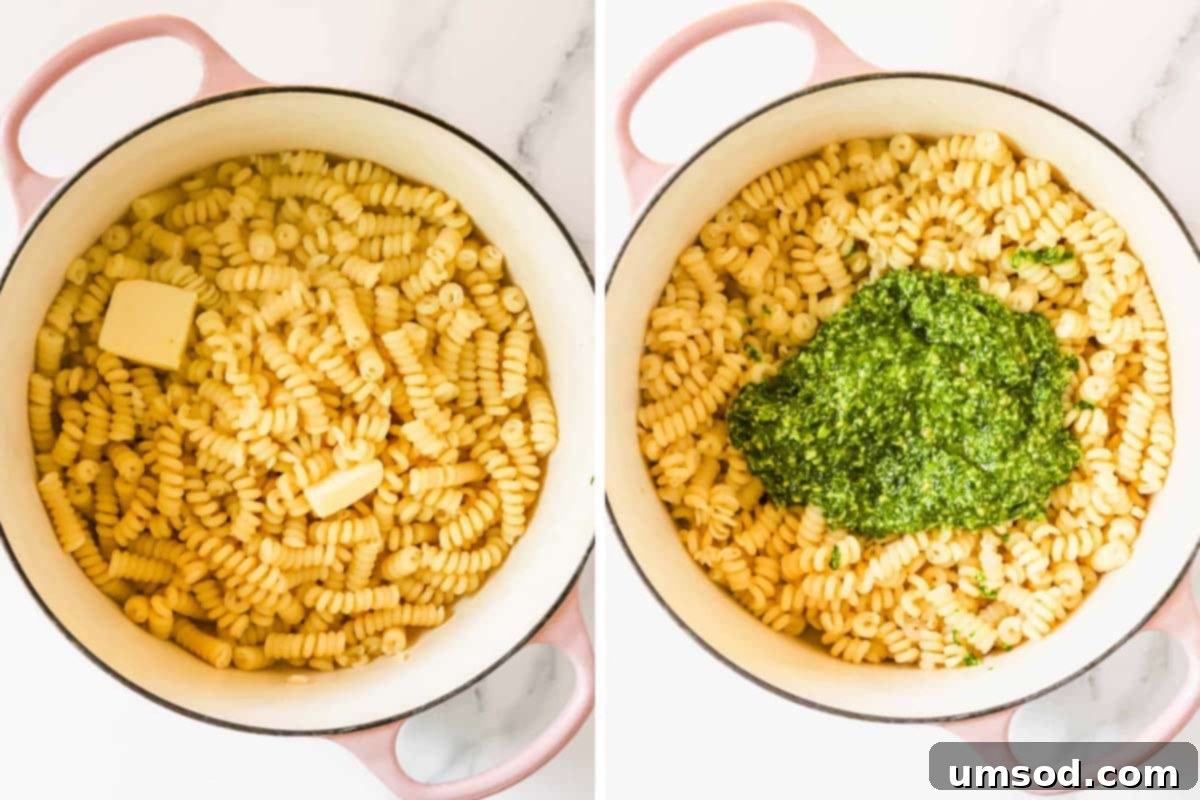
- Serve & Garnish: Transfer the delicious basil pesto pasta to a serving bowl. For a final touch, generously top with extra freshly grated Parmesan cheese and a few fresh basil leaves. Serve immediately and savor every bite!
Smart Time Management Tip:
To maximize efficiency and truly achieve that 15-minute meal, start boiling your pasta water first. While the noodles are cooking to al dente, you can concurrently prepare your homemade basil pesto. This strategy ensures that your pesto is freshly made and ready to be tossed with the hot pasta the moment it’s drained, eliminating any waiting time and streamlining your cooking process!
Essential Tips for Perfect Pesto Pasta Every Time:
Achieving restaurant-quality basil pesto pasta at home is simpler than you think with these expert tips:
- Always Save That Pasta Water! This is arguably the most crucial tip for a truly authentic and creamy pasta sauce. The starchy water left over from cooking the pasta is like liquid gold. When added to the pasta and pesto, it helps to emulsify the sauce, creating a silky texture that beautifully clings to every noodle. It acts as a natural thickener and binder, ensuring your pesto isn’t just sitting on top but embracing the pasta.
- Prioritize Freshly Grated Parmesan: While convenient, pre-grated Parmesan from the store often contains anti-caking agents (like cellulose) that prevent it from melting smoothly and can give your sauce a grainy texture. For the best flavor, texture, and melt, always grate your Parmesan cheese fresh from a block. The difference in taste and creaminess is remarkable.
- Cook Your Pasta Precisely to Al Dente: Overcooked, mushy pasta is the enemy of a great pesto dish. Aim for an al dente texture – meaning the pasta should be tender when bitten but still have a slight firmness or “tooth.” This ensures the noodles hold their shape, provide a satisfying chew, and can stand up to the richness of the pesto without becoming soggy. It also prevents the pasta from breaking down when mixed with the sauce.
- Avoid Overprocessing the Pesto: While a smooth pesto is desirable, over-blending can generate too much heat, which can oxidize the basil and turn your vibrant green pesto a dull brown, or even give it a slightly bitter taste. Pulse the ingredients until combined and just smooth enough, rather than continuously blending. A little texture is a good thing!
- Taste and Adjust Seasoning: Before serving, always taste your pesto pasta. Depending on the saltiness of your cheese and pasta water, you might need to add a touch more kosher salt, a grind of black pepper, or another squeeze of fresh lemon juice to brighten the flavors. Adjusting the seasoning to your palate is key to a truly personalized and delicious dish.
- Serve Immediately for Best Results: While leftovers are still delicious, basil pesto pasta is at its absolute peak when enjoyed fresh and warm. The flavors are most vibrant, and the pasta texture is ideal.
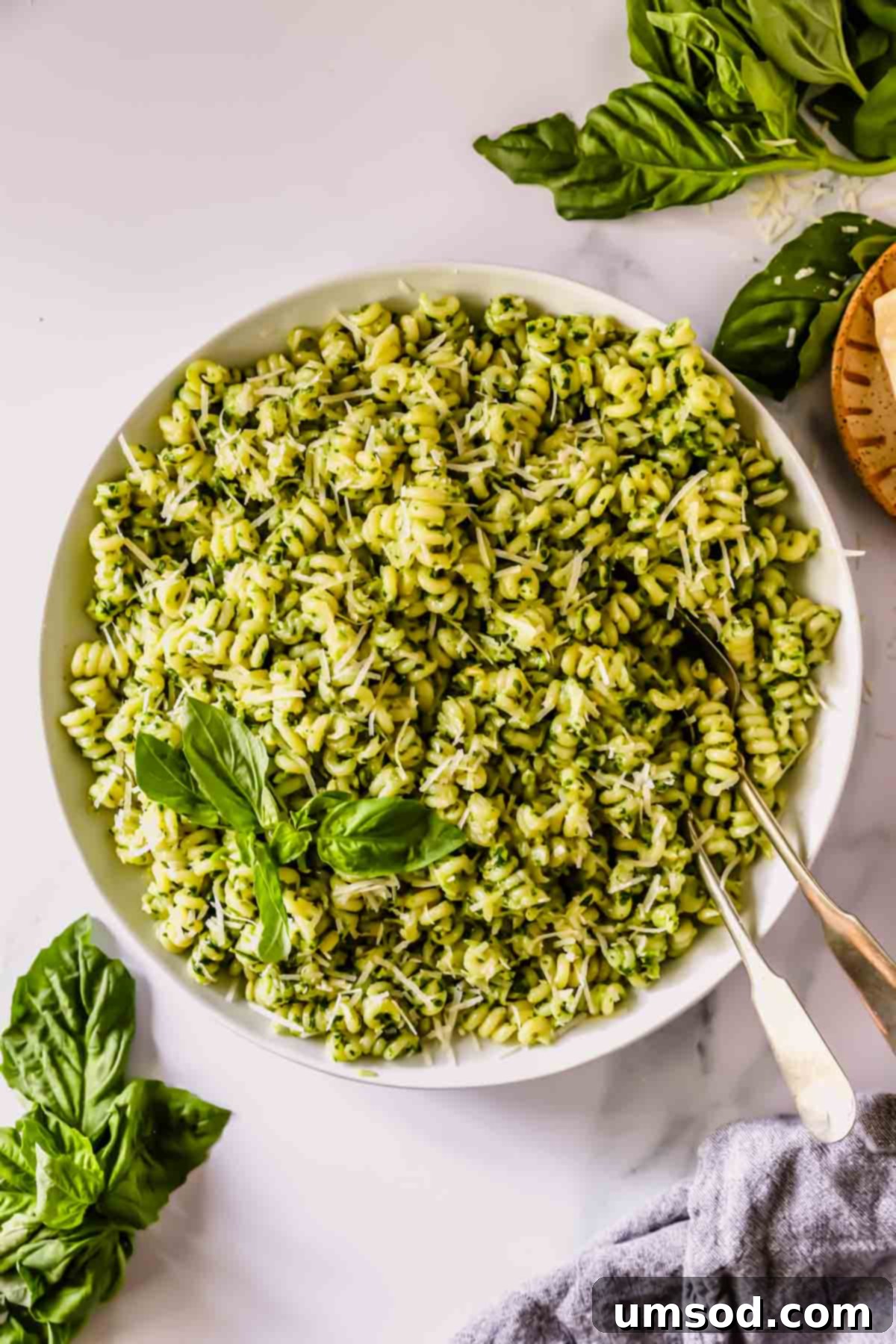
Creative Variations & Customizations for Your Pesto Pasta
One of the joys of basil pesto pasta is its incredible versatility. Don’t hesitate to get creative and tailor this recipe to your tastes or what you have on hand. Here are some ideas to inspire you:
- Boost with Protein: For a heartier meal, easily add cooked protein. Grilled chicken breast, sautéed shrimp, Italian sausage, or even flaked salmon are fantastic additions. For a plant-based protein boost, consider stirring in cannellini beans or chickpeas.
- Add More Vegetables: Enhance the nutritional value and visual appeal with extra veggies. Halved cherry tomatoes (fresh or roasted), sautéed mushrooms, wilted spinach or kale, roasted asparagus, steamed broccoli florets, or sun-dried tomatoes offer wonderful flavors and textures. Roasted bell peppers also add a delicious sweetness.
- Cheese Alternatives: Experiment with different cheeses! Fresh mozzarella balls (bocconcini or ciliegine) are delightful when tossed in, offering pockets of creamy goodness. Crumbled feta or goat cheese can provide a tangy contrast.
- Nut-Free Pesto: If dealing with nut allergies or simply prefer a different flavor, sunflower seeds or pumpkin seeds can be excellent substitutes for pine nuts in the pesto. Cashews can also work, offering a very creamy texture.
- Spice It Up: For those who love a little heat, a pinch of red pepper flakes stirred into the pasta at the end will add a delightful kick.
- Herb Variations: While basil is king, you can blend it with other herbs. A mix of basil and parsley, or even a touch of mint, can introduce new dimensions of flavor to your pesto.
- Dairy-Free Option: To make the pesto dairy-free, substitute the Parmesan cheese with nutritional yeast, which offers a cheesy, umami flavor.
Elevate Your Meal: Inspired Serving Suggestions
While basil pesto pasta is a complete and satisfying meal on its own, pairing it with complementary dishes can elevate your dining experience. Here are some ideas:
- Classic Accompaniments: Serve alongside a fresh, crisp green salad with a simple vinaigrette (like a Caesar salad or arugula with lemon dressing) and warm, crusty garlic breadsticks or bruschetta to sop up every last drop of that delicious pesto sauce.
- Hearty Mains: If you’re serving the pasta as a side, it pairs beautifully with grilled proteins. Think perfectly cooked grilled steak, juicy baked salmon, pan-seared scallops, or tender roasted chicken.
- Light & Fresh: For a lighter meal, simply add some steamed or roasted vegetables like asparagus, green beans, or cherry tomatoes directly into the pasta.
- Wine Pairing: Complement the fresh, herbaceous notes of the pesto with a light-bodied, crisp white wine. Sauvignon Blanc, Pinot Grigio, or a dry Rosé would be excellent choices.
Smart Make-Ahead Strategies: Pesto Prepared for Convenience
This basil pesto pasta recipe is undoubtedly at its best when enjoyed warm and freshly prepared. However, its brilliant convenience is amplified by the fact that you can make the star of the show – the basil pesto – well in advance. Preparing a larger batch of pesto is a fantastic way to ensure you always have this vibrant sauce on hand for quick meals, not just this pasta dish, but for other delicious creations like pesto mozzarella chicken meatballs or a creamy 5-ingredient pesto artichoke dip!
To prepare your pesto ahead of time:
- Prepare the Pesto: Follow the recipe instructions for making the basil pesto.
- Seal & Store in the Fridge: Transfer the fresh pesto into a glass airtight container. To prevent oxidation (which can turn the top layer of pesto brown), pour a thin layer of extra virgin olive oil over the surface before sealing it tightly with a lid. Stored this way, your homemade pesto will remain fresh and vibrant in the refrigerator for up to 1 week.
- Freeze for Longer Storage: For extended freshness, pesto freezes beautifully! You can freeze it in small portions in an ice cube tray, then transfer the frozen cubes to a freezer-safe bag. Alternatively, store it directly in an airtight container, again with a thin layer of olive oil on top. Pesto will stay fresh in the freezer for 2-3 months.
- Ready for Pasta Night: When you’re ready to make your basil pesto pasta, simply cook the noodles as usual. If using frozen pesto, allow it to thaw in the refrigerator or at room temperature for a couple of hours. Give your pesto a good stir before combining it with the hot pasta and the rest of the ingredients.
Smart Storing & Reheating for Leftover Pesto Pasta:
While this basil pesto pasta is truly at its peak when enjoyed fresh and warm, it’s inevitable (and often desirable!) to have leftovers. Luckily, storing and reheating this dish is straightforward, allowing you to savor its deliciousness for another meal.
- Proper Storage: First, allow your basil pesto pasta to cool completely to room temperature. This is crucial to prevent condensation, which can lead to soggy pasta and potential bacterial growth. Once cooled, transfer the pasta to an airtight container. It will remain fresh and delicious in the refrigerator for 3-4 days.
- Reheating for Freshness: The best way to reheat leftover basil pesto pasta is gently on the stovetop. Transfer the pasta to a skillet and warm it over medium-low heat, stirring occasionally. To help revive its creamy texture and prevent it from drying out, add a splash of reserved pasta water (if you saved extra), a teaspoon of fresh olive oil, or even a small spoonful of fresh pesto (if you have it handy). This will re-moisten the noodles and refresh the flavors. You can also microwave it in short intervals, stirring in between, but the stovetop method yields superior results.
- Freezing Cooked Pesto Pasta: While it’s generally recommended to freeze the pesto separately rather than the cooked pasta (as pasta can become mushy upon thawing), if you must freeze leftover pasta, ensure it’s in an airtight, freezer-safe container. It can last for up to 1 month, but expect a softer texture after reheating.

Your Top Basil Pesto Pasta Questions Answered:
Basil pesto pasta is incredibly versatile! For a light meal, serve it with simple appetizers and side dishes such as a fresh green salad, crisp garlic breadsticks, a classic Caesar salad, or steamed vegetables like asparagus or green beans. If you’re looking for a heartier meal, it makes an excellent side dish for protein sources like grilled steak, baked salmon, pan-seared shrimp, or even a succulent roasted rack of lamb. The key is to balance the richness of the pesto with fresh, bright flavors.
You can certainly use any pasta shape you enjoy most for this recipe, as the fresh pesto sauce is delicious with everything! However, for optimal sauce adhesion, I highly recommend choosing medium-sized pasta varieties that have ridges, spirals, or nooks and crannies. Shapes like fusilli corti, cavatappi, penne, rotini, or orecchiette are fantastic because their unique textures act like tiny scoops, capturing and holding all that flavorful pesto. Even long pastas like spaghetti or linguine work wonderfully as the sauce clings to the strands. If you need a dietary alternative, gluten-free pasta varieties also work perfectly.
There’s absolutely no need to warm the pesto separately before adding it to your pasta. The residual heat from the freshly cooked, hot pasta is more than sufficient to gently warm the pesto sauce. Tossing the pesto directly with the hot noodles, butter, and a splash of reserved pasta water allows the flavors to meld beautifully and creates a silky, emulsified sauce without overcooking the delicate fresh basil.
Absolutely! While a food processor makes quick work of pesto, you can certainly make it the traditional way with a mortar and pestle for an even more rustic texture. Alternatively, a blender can be used, but be careful not to overprocess, as the blades can generate heat and cause the basil to oxidize or become bitter. Pulse in short bursts and scrape down the sides frequently.
Several factors can contribute to bitter pesto. Overprocessing in a food processor or blender can generate heat that oxidizes the basil, leading to bitterness. Using old or bruised basil leaves, or adding too much garlic (especially if it’s not fresh), can also result in an overly pungent or bitter flavor. Ensure your basil is fresh, your garlic is balanced, and you pulse rather than continuously blend the ingredients.
Explore More Irresistible Pasta Recipes:
If you’ve fallen in love with the ease and flavor of this basil pesto pasta, you’ll surely enjoy exploring other delicious pasta creations. Here are some more recipes to inspire your next meal:
- Easy Brown Butter Pasta Recipe
- Pesto Ricotta Stuffed Pasta Shells
- Tequila Lime Seared Scallops Pasta
- Flavorful Veggie Pasta Salad

Basil Pesto Pasta
Comment
Print Recipe
Ingredients
Basil Pesto
- 3 cups fresh basil, packed
- ¼ cup pine nuts
- ½ cup parmesan cheese, freshly grated
- 2 cloves garlic
- 1 tablespoon lemon juice
- 1 teaspoon kosher salt, or more to taste
- ½ cup extra virgin olive oil
Pasta
- 1 pound fusilli corti pasta, or your favorite pasta (Note 1)
- Kosher salt, to taste for water
- 2 tablespoons unsalted butter
- ¼ cup parmesan cheese, for topping
Equipment
- 1 food processor
Instructions
Make the Basil Pesto
- While the pasta cooks, prepare the pesto. Add the basil, pine nuts, Parmesan cheese, garlic, lemon juice, and kosher salt to a food processor. Pulse until all the ingredients are finely chopped and well combined. Then, add in the olive oil and pulse a few more times until a smooth, yet slightly textured, pesto sauce is formed.
Cook the Pasta & Combine
- Cook your chosen pasta according to the package instructions in generously salted water until al dente. Before draining, reserve about ¼ cup of the starchy pasta water. Drain the pasta.
- Return the hot pasta to the pot. Add the unsalted butter and the reserved pasta water. Gently toss to combine, coating the noodles in the buttery, starchy liquid.
- Add the freshly made basil pesto to the pasta. Mix thoroughly until all the noodles are evenly coated in the vibrant sauce.
- Transfer the pesto pasta to a serving bowl. Finish by topping with extra freshly grated Parmesan cheese and a few fresh basil leaves. Serve immediately and enjoy this quick and flavorful dish!
⭐️ Did you make this recipe?
Please leave a review and let us know how you liked it!
Tips & Notes
Storing Tips:
– Allow leftovers to cool completely to room temperature before storing.
– Transfer them to an airtight container and store in the fridge for up to 3-4 days.
– Reheat in a skillet over medium-low heat, adding a splash of water or olive oil if needed to refresh.
Nutrition
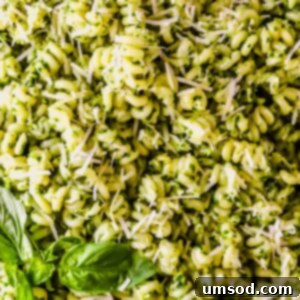
Did you make this?
Leave a rating and your feedback. Thank you!
